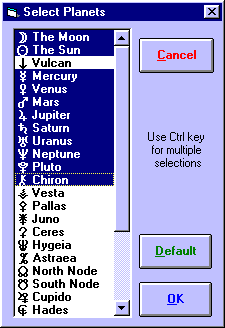Selecting Displayed Points
It is possible to display any combination of up to 33 planets, asteroids, hypothetical planets and an additional 36 fixed stars on a map at any time. Most users will probably wish to display just the standard set of planets. However, in some circumstances you may wish to increase the number of points displayed, or in others select just a single planet to be displayed on a map.
>> |
To select which points to display on the map |
Select the ÔÇťDisplayed Points...ÔÇť item from the ÔÇťChartÔÇť menu.
This will display the ÔÇťSelect PlanetsÔÇŁ dialog box.

The list box on the left contains a list of all the points which it is possible to display. Normally this will be a list of the 33 planets, asteroids and hypothetical planets. However, if you have previously opened a fixed star file, then there will also be up to 36 fixed stars at the bottom of the list. You can see items lower down on the list by using the scroll bar on the right hand side of the list box. Items which are currently selected for display are highlighted. Items which are available for display, but currently unselected, are not highlighted.
>> |
To select or unselect any single point in the list |
Hold down the ÔÇťCtrlÔÇť key and click on the desired item in the list.
This will switch the point on if it was previously unselected, or switch it off if it was previously selected.
If you do not hold down the ÔÇťCtrlÔÇť key then you will switch on only that item, and everything else will be switched off.
There is also a shortcut to restoring the ÔÇťdefaultÔÇŁ selection of displayed points. If you are running Solar Fire, and have called Solar Maps from within Solar Fire, then the ÔÇťdefaultÔÇŁ selection is the same set of points which are the current displayed points in Solar Fire. If you are running Solar Maps on its own, then the ÔÇťdefaultÔÇŁ selection is the standard set of planets plus the lunar nodes.
>> |
To reset the selection to the default |
Click on the ÔÇťDefaultÔÇť button.
Once you have made your selection, you can return to view the map with the newly selected lines displayed.
>> |
To return to the map |
Click on the ÔÇťOKÔÇť button.
Note: If you are currently displaying a map of the world, then selecting a large number of points may result in an overcrowded screen and some map symbols may overflow off the edge of the map. It is recommended that you only select a large number of points if you are viewing a regional map, or if you are only viewing a small number of line types.
